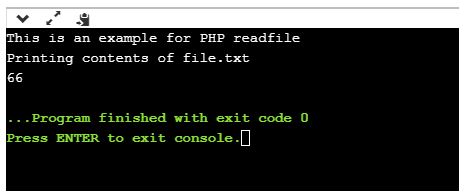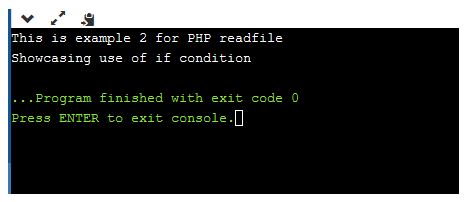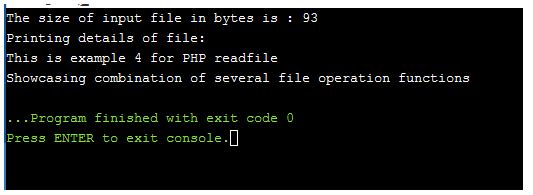PHP读取文件
PHP readfile 基本上是 PHP 库中的一个内置函数,用于读取文件然后将其写入输出缓冲区。
开始您的免费软件开发课程
网络开发、编程语言、软件测试及其他
语法:
readfile ( string $file_name [, boolean $path = FALSE [, resource $context ]] ) : int
语法中使用的参数:
- 文件名:这是必填字段,我们在其中提供要读取的文件的名称。
- 路径:这是一个可选参数,是一个布尔值,如果需要在提供的路径中搜索文件,则可以将其设置为 true 或 false。
- context: 这也是一个可选字段,用于指定文件句柄的上下文。基本上,上下文是能够更改该流的行为的对象的集合。如果成功则返回从文件中读取的字节数,如果读取失败则返回 false。
PHP 读取文件的方法
除了 readfile() 函数之外,以下是一些可用于对文件执行各种操作的其他函数。
1.文件()
此函数还用于读取文件,它将完整的文件读取到数组中。
语法:
file ( string $file_name [, int $flag = 0 [, resource $context ]] ) : array
其中file_name是要读取的文件的路径。标志是可选字段,可以从以下常量中选择:
- FILE_USE_INCLUDE_PATH: 在给定路径中搜索相应的文件。
- FILE_IGNORE_NEW_LINES: 在每个数组元素的最后省略一个新行。
- FILE_SKIP_EMPTY_LINES: 跳过空行。
成功时返回数组中存在的文件,失败时返回 false。
2. fopen()
此函数可用于打开文件和 URL。
fopen ( string $file_name , string $mode [, bool $use_include_path = FALSE [, resource $context ]] ) : resource
- 如果 file_name 是 URL,则 PHP 会在协议处理程序(也称为包装器)中搜索它。 PHP 将发出通知来帮助跟踪脚本中可能存在的问题,然后继续将其视为正常的常规 file_name。
- 假设如果 file_name 是本地文件,则 PHP 尝试在该文件上打开相同的流。仅当授予其访问所需的权限时,PHP 才能访问该文件。
- 假设给定的 file_name 是一个已注册的协议,并且如果该协议已注册为网络 URL,则第一个 PHP 确保启用了allow_url_fopen。如果禁用,它将发出警告并失败。
模式:此参数提到了需要授予流的访问权限类型。下面是一些重要的模式:
- r – 仅读取模式
- r+ – 只能读和写
- w – 仅写入模式
如果成功则返回文件指针资源,如果失败则返回 false。
3. fread()
此函数用于二进制安全文件读取。
语法:
fread ( resource $handle , int $length ) : string
句柄用于引用文件指针。
文件将被读取,直到达到以下条件之一:长度(以字节为单位)必须已读取、达到 EOF、发生套接字超时。 fgets()、fscanf()、ftell()、fwrite()、fopen()、fsockopen() 是 PHP 中用于文件操作的其他一些函数。
PHP 读取文件示例
下面给出的是 PHP 读取文件的示例:
示例#1
代码:
<?php
// it is writing content of file to output
// buffer used in readfile() function
echo readfile("file.txt");
?>输出:

这显示了读取本地路径中存在的文件的基本示例。确保创建了 readfile() 函数参数中指定的文件名,并且要读取的内容存在于文件内。当使用 readfile() 函数时,它会读取文件的内容并在输出中打印。
示例#2
代码:
<?php
/ file contents written on output
// buffer by readfile() function
$file = @readfile("file.txt");
if (!$file)
{
print "File could not be opened";
}
?>输出:

之前的输出是一个没有任何条件的简单示例。在此示例中,让我们看看如何使用某些条件读取并显示文件的输出。我们使用 if 语句来打印假设文件不存在。
示例 #3
代码:
<?php $file_name = "file.txt"; $fh = fopen($file_name, 'r'); $data = fread($fh, filesize($file_name)); fclose($fh); echo $data; ?>
输出:

In this example, we are combining the use of multiple file read functions. As in all the above examples, first, we are giving the file name which needs to be read from. Then the mode of operation, ‘r’ is given to them indicating it can only be read. filesize() function takes the filename and returns the size of the file along with its data and assigns it to $data variable. By using fclose() function we are closing that file. Finally, the data is printed as output.
Example #4
Code:
<?php
$file_name = "file.txt";
$file = fopen( $file_name , "r" );
if( $file == false ) {
echo ( "Error in opening file" );
exit();
}
$size = filesize( $file_name );
$filetext = fread( $file, $size);
fclose( $file );
echo ( "The size of input file in bytes is : $size\n" );
echo ("Printing details of file:\n");
echo ( $filetext );
?>Output:

Before running the code, make sure that the file to be read file.txt is created in the local file path. In this example first, we are declaring the file name to be read and opening that with the function fopen(). Suppose the file does not exist, using if condition we are throwing an error message. Finally, we are printing the file size and the content present in the input file.
Conclusion
As seen from all the above examples, readfile() is one of the main functions of PHP used for reading the file name specified in this function. Apart from readfile() we have covered a few other file operations which perform similar actions such as fopen, file, fread, fgets, fgetss, ftell, etc. A combination of all of these are basically used in accessing and performing operations on the input file.
以上是PHP读取文件的详细内容。更多信息请关注PHP中文网其他相关文章!

热AI工具

Undresser.AI Undress
人工智能驱动的应用程序,用于创建逼真的裸体照片

AI Clothes Remover
用于从照片中去除衣服的在线人工智能工具。

Undress AI Tool
免费脱衣服图片

Clothoff.io
AI脱衣机

Video Face Swap
使用我们完全免费的人工智能换脸工具轻松在任何视频中换脸!

热门文章

热工具

记事本++7.3.1
好用且免费的代码编辑器

SublimeText3汉化版
中文版,非常好用

禅工作室 13.0.1
功能强大的PHP集成开发环境

Dreamweaver CS6
视觉化网页开发工具

SublimeText3 Mac版
神级代码编辑软件(SublimeText3)
 适用于 Ubuntu 和 Debian 的 PHP 8.4 安装和升级指南
Dec 24, 2024 pm 04:42 PM
适用于 Ubuntu 和 Debian 的 PHP 8.4 安装和升级指南
Dec 24, 2024 pm 04:42 PM
PHP 8.4 带来了多项新功能、安全性改进和性能改进,同时弃用和删除了大量功能。 本指南介绍了如何在 Ubuntu、Debian 或其衍生版本上安装 PHP 8.4 或升级到 PHP 8.4
 如何设置 Visual Studio Code (VS Code) 进行 PHP 开发
Dec 20, 2024 am 11:31 AM
如何设置 Visual Studio Code (VS Code) 进行 PHP 开发
Dec 20, 2024 am 11:31 AM
Visual Studio Code,也称为 VS Code,是一个免费的源代码编辑器 - 或集成开发环境 (IDE) - 可用于所有主要操作系统。 VS Code 拥有针对多种编程语言的大量扩展,可以轻松编写
 在PHP API中说明JSON Web令牌(JWT)及其用例。
Apr 05, 2025 am 12:04 AM
在PHP API中说明JSON Web令牌(JWT)及其用例。
Apr 05, 2025 am 12:04 AM
JWT是一种基于JSON的开放标准,用于在各方之间安全地传输信息,主要用于身份验证和信息交换。1.JWT由Header、Payload和Signature三部分组成。2.JWT的工作原理包括生成JWT、验证JWT和解析Payload三个步骤。3.在PHP中使用JWT进行身份验证时,可以生成和验证JWT,并在高级用法中包含用户角色和权限信息。4.常见错误包括签名验证失败、令牌过期和Payload过大,调试技巧包括使用调试工具和日志记录。5.性能优化和最佳实践包括使用合适的签名算法、合理设置有效期、
 您如何在PHP中解析和处理HTML/XML?
Feb 07, 2025 am 11:57 AM
您如何在PHP中解析和处理HTML/XML?
Feb 07, 2025 am 11:57 AM
本教程演示了如何使用PHP有效地处理XML文档。 XML(可扩展的标记语言)是一种用于人类可读性和机器解析的多功能文本标记语言。它通常用于数据存储
 解释PHP中的晚期静态绑定(静态::)。
Apr 03, 2025 am 12:04 AM
解释PHP中的晚期静态绑定(静态::)。
Apr 03, 2025 am 12:04 AM
静态绑定(static::)在PHP中实现晚期静态绑定(LSB),允许在静态上下文中引用调用类而非定义类。1)解析过程在运行时进行,2)在继承关系中向上查找调用类,3)可能带来性能开销。
 php程序在字符串中计数元音
Feb 07, 2025 pm 12:12 PM
php程序在字符串中计数元音
Feb 07, 2025 pm 12:12 PM
字符串是由字符组成的序列,包括字母、数字和符号。本教程将学习如何使用不同的方法在PHP中计算给定字符串中元音的数量。英语中的元音是a、e、i、o、u,它们可以是大写或小写。 什么是元音? 元音是代表特定语音的字母字符。英语中共有五个元音,包括大写和小写: a, e, i, o, u 示例 1 输入:字符串 = "Tutorialspoint" 输出:6 解释 字符串 "Tutorialspoint" 中的元音是 u、o、i、a、o、i。总共有 6 个元
 什么是PHP魔术方法(__ -construct,__destruct,__call,__get,__ set等)并提供用例?
Apr 03, 2025 am 12:03 AM
什么是PHP魔术方法(__ -construct,__destruct,__call,__get,__ set等)并提供用例?
Apr 03, 2025 am 12:03 AM
PHP的魔法方法有哪些?PHP的魔法方法包括:1.\_\_construct,用于初始化对象;2.\_\_destruct,用于清理资源;3.\_\_call,处理不存在的方法调用;4.\_\_get,实现动态属性访问;5.\_\_set,实现动态属性设置。这些方法在特定情况下自动调用,提升代码的灵活性和效率。
 PHP和Python:比较两种流行的编程语言
Apr 14, 2025 am 12:13 AM
PHP和Python:比较两种流行的编程语言
Apr 14, 2025 am 12:13 AM
PHP和Python各有优势,选择依据项目需求。1.PHP适合web开发,尤其快速开发和维护网站。2.Python适用于数据科学、机器学习和人工智能,语法简洁,适合初学者。






